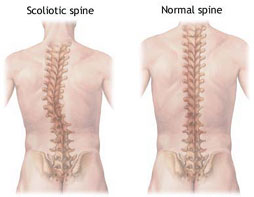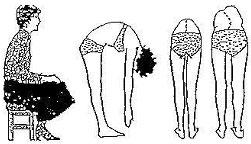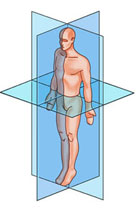|
|
Scoliosis - abnormal curvature of the spine
 Scoliosis is a bending and twisting of the spinal column affecting mainly
the thoracic (middle spine) or the lumbar (lower spine) it is sometimes
progressive and distorts the chest and back. If left untreated, can lead to
severe deformity. Scoliosis is a bending and twisting of the spinal column affecting mainly
the thoracic (middle spine) or the lumbar (lower spine) it is sometimes
progressive and distorts the chest and back. If left untreated, can lead to
severe deformity.
The spine has an important role. The spine supports our erect posture,
stabilizes our limbs relative to our trunks, supports our abdominal and thoracic
regions, and protects our neural elements. The spine is in balance when the head
is aligned with the pelvis. Scoliosis is a condition in which the spine is
curved in the coronal or frontal plane. The coronal plane is the view from the
crown (corona) of the head down. The frontal plane is the view of the body from
the front. Scoliosis encompasses curves of 10 degrees and greater.
Besides physical deformity, it can lead to malfunctioning of organs that get
misplaced and misaligned, causing problems of the respiratory, digestive,
endocrine and other body systems. In rare, severe cases, scoliosis can lead to
premature death.
straight
spine is essential for good health.-It ensures that all the organs of the
body are in their rightful places and that nerve signals are transmitted
smoothly from the brain via the spinal cord to the rest of the body.
|
Process:
The process of scoliosis
development goes as follows:
First, the spine does not develop
its normal front to back arches, and this causes unusual weight to be carried on
the spinal discs.
Second, the center of certain
discs shifts to one side, and the vertebra tip to the other side, just like a
teeter totter. This misalignment, called a subluxation, causes the spine to tip
to one side. To compensate for this bend, the spine then tips to the other side
at another level and the result is scoliosis.
Possible
causes :
Scoliosis
may be caused by a number of factors, including:
-
Abnormalities
in the vertebra at birth.
-
Regular and prolonged improper
use of the body, such as carrying heavy loads on one side of the body;
-
Flat feet, uneven leg lengths
and other conditions that cause a person to walk in an unbalanced manner;
-
Uneven stress or muscle tension,
whereby the muscles on some parts of the body are perpetually more tense /
tighter than other parts.
-
Extreme dietary imbalances and
nutritional deficiency.
-
-
-
Other injuries to the developing
spine.
Screening
for scoliosis :
Often, family or friends first detect scoliosis in an adolescent by noticing an asymmetry in the shoulders, rib cage, waist, or pelvis. Screening is useful if
early identification permits treatment that may halt the progression of the
deformity. A Simple test to recognize Scoliosis is by bending over from
the waist while keeping the legs and arms straight and the palms together. From
the rear, a clear rib bulge (as in the picture) will be visible if one has
scoliosis. A common sign of the problem is one shoulder blade being more
prominent than the other, with the tendency to lean a little to one side.
The hips may be uneven.
asymmetry in the shoulders, rib cage, waist, or pelvis. Screening is useful if
early identification permits treatment that may halt the progression of the
deformity. A Simple test to recognize Scoliosis is by bending over from
the waist while keeping the legs and arms straight and the palms together. From
the rear, a clear rib bulge (as in the picture) will be visible if one has
scoliosis. A common sign of the problem is one shoulder blade being more
prominent than the other, with the tendency to lean a little to one side.
The hips may be uneven.
Treatment Options:
Nearly all patients with adult
scoliosis will respond to conservative treatment and lead a normal, functional
life. When pain is present, it is usually short term and manageable.
Treatment for adult scoliosis should almost always begin with a non-invasive
approach.
Non-steroid Anti-inflammatory
Drugs (NSAID) have been the cornerstone of medical therapy for arthritic
and inflammatory conditions. These medications can quiet the pain and
stiffness caused by degenerating discs and joints.
Physical Therapy is an
excellent way to improve function, flexibility, endurance, and decrease pain. Usually the therapist will work with
patients toward becoming less symptomatic, and maintaining the improvement
with an active home exercise program. Working out in a supervised
environment with the help of a physical therapist is the best way to achieve
it. On average, therapy lasts 2 - 3 times per week for 4 - 8 weeks.
endurance, and decrease pain. Usually the therapist will work with
patients toward becoming less symptomatic, and maintaining the improvement
with an active home exercise program. Working out in a supervised
environment with the help of a physical therapist is the best way to achieve
it. On average, therapy lasts 2 - 3 times per week for 4 - 8 weeks.
It is very important that adult
patients with scoliosis get into the habit of doing a daily exercise routine.
This will improve the strength of the trunk muscles and take some of the
stress off from the spine. Often when pain occurs, it is because the
patient is not doing his or her exercises.
Back brace is helpful in
getting some relief from back pain in patients with degenerative scoliosis. In 1983, Dr. Copes invented the Copes Scoliosis
Dynamic Brace. For more than 20 years he has specialized in treatment and
research of scoliosis. Each Copes brace is designed to obtain at least 20
degrees of correction. When used in conjunction with the Scoliosis Treatment
and Recovery System (STRS) there can often times be up to a 50% or more
correction over a period of 18 - 36 months. Time depends on the range of
curvature and compliance with the program. A word of caution is in order
however: the brace should not be used without faithful compliance with an
active exercise program. Brace wear without exercise tends to lead to a
weaker spine that becomes dependent on the brace. Daily exercises and
occasional (when needed) brace wear lead to the best results, where bracing is
concerned.
degenerative scoliosis. In 1983, Dr. Copes invented the Copes Scoliosis
Dynamic Brace. For more than 20 years he has specialized in treatment and
research of scoliosis. Each Copes brace is designed to obtain at least 20
degrees of correction. When used in conjunction with the Scoliosis Treatment
and Recovery System (STRS) there can often times be up to a 50% or more
correction over a period of 18 - 36 months. Time depends on the range of
curvature and compliance with the program. A word of caution is in order
however: the brace should not be used without faithful compliance with an
active exercise program. Brace wear without exercise tends to lead to a
weaker spine that becomes dependent on the brace. Daily exercises and
occasional (when needed) brace wear lead to the best results, where bracing is
concerned.
Surgical
Technique to Correct Scoliosis
Surgery to correct adult
scoliosis is the most challenging surgery done in orthopedics, and is likely
among the most complex and demanding surgeries of any kind being performed
today. This type of surgery requires at least one assisting surgeon and
often a surgical team, and can take from 4 - 14 hours to accomplish.
Anterior Surgery - If the
spine must be fused anterior or from the front, a thoracic or general surgeon
will be a part of the surgical team to safely mobilize the great blood vessels
off the spine where the spine surgeon will work. The incision may be
through the side of the chest, through the side of the abdomen, or through the
front of the abdomen, depending on what is needed at the time of surgery.
The purpose of anterior surgery is to remove the discs, and fill the space
with bone graft. This serves to improve the correction which can be
achieved and improve the reliability of the fusion. Sometimes the spine
is "instrumented" from the front, meaning that screws are placed into the
vertebra and attached to a rod that will correct the deformity and stabilize
the spine.
More recently, the thoracoscope
has been used in spine surgery. We can now remove discs from the
thoracic spine and insert bone graft without making a large incision.
All of the work is done through a few one-inch incisions on the side of the
chest.
Posterior Surgery - Most
of the correction of scoliosis is done from the back of the spine. If nerves are compressed by bone spurs or a disc herniation,
the offending structures can be removed to allow more room for the nerves.
The spine is then "instrumented" by the placement of hooks or screws that
attach to the vertebrae. These hooks and screws are then attached to rods that
span the curve. The instrumentation is then distracted, compressed, or rotated
in order to correct the spinal curvature. Without instrumentation, the
curve cannot be corrected.
back of the spine. If nerves are compressed by bone spurs or a disc herniation,
the offending structures can be removed to allow more room for the nerves.
The spine is then "instrumented" by the placement of hooks or screws that
attach to the vertebrae. These hooks and screws are then attached to rods that
span the curve. The instrumentation is then distracted, compressed, or rotated
in order to correct the spinal curvature. Without instrumentation, the
curve cannot be corrected.
Bone graft is always used in
scoliosis surgery. The spine must be fused in its new corrected and
straightened position. The graft most commonly comes from the patient's
own pelvis. Sometimes bone-bank bone is used when there is not
sufficient bone available form the patient. As the bone graft heals over the
next several months, the spine becomes solid and will not curve again. But the
part of the spine that has not been fused will still be flexible, and allow
nearly normal overall movement.
Management
of Scoliosis :
Management options are
determined by the:
-
Degree of the deformity
-
Location of the deformity
-
Cause of the deformity
-
Age of the patient
-
Skeletal maturity of the
patient
-
Individual preferences of the
patient and family
According to medical science,
there is "no cure" for scoliosis. The only medical treatment available is
surgery to insert a metal rod into the spine, to force it straight. This is
not an ideal solution, however, as it does not allow free movement of the
individual vertebrae.
|
Can exercises correct a Scoliosis?
:
One must be aware that scoliosis
curves can neither be improved nor their progression prevented by exercises.
However exercises for spine stabilization are beneficial for most people with
spine problems. After careful evaluation by a spine specialist most patients
with scoliosis are encouraged to participate in athletics without reservation
(swimming and bicycling are probably better than running).
It is mostly recommended to engage
in aerobic exercises with limited amount of resistance (no more than 40 lbs.).
Gym exercises can be pursued with upper extremity work outs in sitting and
supine positions, using free weights or machines (nautilus or cybex) to
indirectly strengthen the supportive musculature of the back. Lower extremities
exercises should avoid excessive work in deep knee or hip flexion. Keeping in
shape, maintaining normal weight, eating a balanced diet and avoiding smoking
are all part of a healthy back regimen.
Tools
and Techniques :
Some of the tools and
techniques used in osteopathy for correcting scoliosis include:
Primary attention must be focused
on the DNA/cellular defecits of muscles, ligaments, and bones. Additional
emphasis must include neurological and proprioceptive changes of the central
nervous system, digestive system and endocrine system. Finally, boney
deformities of the spine, ribs and pelvis can be properly addressed.
-
Osteopathic manipulation;
-
Postural exercises such as
Alexander Technique and physiotherapy;
-
Correction for leg length
discrepancy and flat feet through the use of
orthotics.
-
Osteopaths can also advise on
exercise therapy - such as mobilisation-based exercises - that can help
reverse scoliosis. Exercises that emphasize good posture, such as yoga, can be
helpful as well.
Dated 18 January 2013
Related Links
|
|
|
|
|





 Scoliosis is a bending and twisting of the spinal column affecting mainly
the thoracic (middle spine) or the lumbar (lower spine) it is sometimes
progressive and distorts the chest and back. If left untreated, can lead to
severe deformity.
Scoliosis is a bending and twisting of the spinal column affecting mainly
the thoracic (middle spine) or the lumbar (lower spine) it is sometimes
progressive and distorts the chest and back. If left untreated, can lead to
severe deformity. asymmetry in the shoulders, rib cage, waist, or pelvis. Screening is useful if
early identification permits treatment that may halt the progression of the
deformity. A Simple test to recognize Scoliosis is by bending over from
the waist while keeping the legs and arms straight and the palms together. From
the rear, a clear rib bulge (as in the picture) will be visible if one has
scoliosis. A common sign of the problem is one shoulder blade being more
prominent than the other, with the tendency to lean a little to one side.
The hips may be uneven.
asymmetry in the shoulders, rib cage, waist, or pelvis. Screening is useful if
early identification permits treatment that may halt the progression of the
deformity. A Simple test to recognize Scoliosis is by bending over from
the waist while keeping the legs and arms straight and the palms together. From
the rear, a clear rib bulge (as in the picture) will be visible if one has
scoliosis. A common sign of the problem is one shoulder blade being more
prominent than the other, with the tendency to lean a little to one side.
The hips may be uneven.  endurance, and decrease pain. Usually the therapist will work with
patients toward becoming less symptomatic, and maintaining the improvement
with an active home exercise program. Working out in a supervised
environment with the help of a physical therapist is the best way to achieve
it. On average, therapy lasts 2 - 3 times per week for 4 - 8 weeks.
endurance, and decrease pain. Usually the therapist will work with
patients toward becoming less symptomatic, and maintaining the improvement
with an active home exercise program. Working out in a supervised
environment with the help of a physical therapist is the best way to achieve
it. On average, therapy lasts 2 - 3 times per week for 4 - 8 weeks. degenerative scoliosis. In 1983, Dr. Copes invented the Copes Scoliosis
Dynamic Brace. For more than 20 years he has specialized in treatment and
research of scoliosis. Each Copes brace is designed to obtain at least 20
degrees of correction. When used in conjunction with the Scoliosis Treatment
and Recovery System (STRS) there can often times be up to a 50% or more
correction over a period of 18 - 36 months. Time depends on the range of
curvature and compliance with the program. A word of caution is in order
however: the brace should not be used without faithful compliance with an
active exercise program. Brace wear without exercise tends to lead to a
weaker spine that becomes dependent on the brace. Daily exercises and
occasional (when needed) brace wear lead to the best results, where bracing is
concerned.
degenerative scoliosis. In 1983, Dr. Copes invented the Copes Scoliosis
Dynamic Brace. For more than 20 years he has specialized in treatment and
research of scoliosis. Each Copes brace is designed to obtain at least 20
degrees of correction. When used in conjunction with the Scoliosis Treatment
and Recovery System (STRS) there can often times be up to a 50% or more
correction over a period of 18 - 36 months. Time depends on the range of
curvature and compliance with the program. A word of caution is in order
however: the brace should not be used without faithful compliance with an
active exercise program. Brace wear without exercise tends to lead to a
weaker spine that becomes dependent on the brace. Daily exercises and
occasional (when needed) brace wear lead to the best results, where bracing is
concerned. back of the spine. If nerves are compressed by bone spurs or a disc herniation,
the offending structures can be removed to allow more room for the nerves.
The spine is then "instrumented" by the placement of hooks or screws that
attach to the vertebrae. These hooks and screws are then attached to rods that
span the curve. The instrumentation is then distracted, compressed, or rotated
in order to correct the spinal curvature. Without instrumentation, the
curve cannot be corrected.
back of the spine. If nerves are compressed by bone spurs or a disc herniation,
the offending structures can be removed to allow more room for the nerves.
The spine is then "instrumented" by the placement of hooks or screws that
attach to the vertebrae. These hooks and screws are then attached to rods that
span the curve. The instrumentation is then distracted, compressed, or rotated
in order to correct the spinal curvature. Without instrumentation, the
curve cannot be corrected.